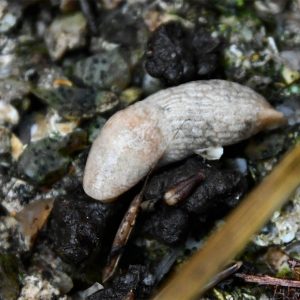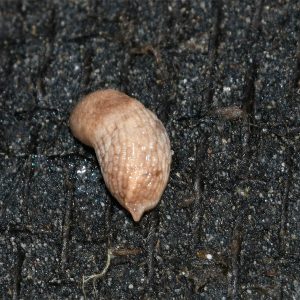A. Invertebrates (Other)
More extensive information on invertebrates can be found in a separate blog post.
B. Slugs (AGRIOLIMACIDAE)
These slugs have a small, internal, asymmetric shell. The species contract protectively when molested.
C. Grey Field Slug (Deroceras reticulatum)
This omnivorous slug is one of our most widespread. It has black-edged tubercles and a milky mucus.
Additional Information
Slug Information
Slugs are unshelled gastropod molluscs, and have the same food preferences as snails, mainly herbivorous, but also omnivorous and carnivorous. Freed from the dependence on Calcium for shell-building, which is why snails have an affinity for alkaline soils, slugs may be found on acidic and neutral soils too. The herbivorous and omnivorous slugs eat rather more dead than living material compared to snails, and as such are useful scavengers and recyclers in the garden. Although their eyesight is poor they detect food with powerful senses of smell and taste through their tentacles, lips, and sole.
Slugs have a horny plate concealed under the mantle, or saddle, but no shell, so maintaining body moisture is essential, which is why they are so active after rain, and during the night when it is cool. Early on dewy mornings is also a good time to search for slugs. Like snails they propel themselves with a muscular ‘foot’. Slugs leave their scent in their slime trails, which assists in navigation and own species recognition. Slugs have teeth, and so can bite, and carnivorous slugs may hunt by following slime trails. When they need to defend themselves they secrete mucus that cements the mouthparts of would-be attackers together. All slugs are hermaphrodites, so when they mate both individuals produce eggs.
Slugs do not need controlling unless they are in a restricted space, and even there many species actually eat dead plants rather than living plants so are no threat to crops. If necessary, strongly smelling native plants with hairy stems help control slugs, such as lavender, rosemary and cranesbills, but better is to encourage hedgehogs, rodents, ground beetles, glow-worms (which feed exclusively on slugs and snails), and birds, so that you create a natural predator/prey relationship. Do not use chemicals, especially if you have pets. Like snails, slugs are great survivors, and of the approximately 40 UK species none has been listed as extinct in recent times.







